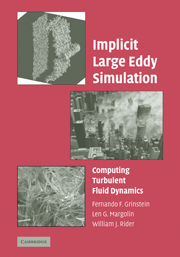Book contents
- Frontmatter
- Contents
- Preface
- List of Acronyms
- List of Contributors
- Introduction
- SECTION A MOTIVATION
- SECTION B CAPTURING PHYSICS WITH NUMERICS
- SECTION C VERIFICATION AND VALIDATION
- SECTION D FRONTIER FLOWS
- 14 Studies of Geophysics
- 15 Using PPM to Model Turbulent Stellar Convection
- 16 Complex Engineering Turbulent Flows
- 17 Large-Scale Urban Simulations
- 18 Outlook and Open Research Issues
- Index
- Plate section
14 - Studies of Geophysics
from SECTION D - FRONTIER FLOWS
Published online by Cambridge University Press: 08 January 2010
- Frontmatter
- Contents
- Preface
- List of Acronyms
- List of Contributors
- Introduction
- SECTION A MOTIVATION
- SECTION B CAPTURING PHYSICS WITH NUMERICS
- SECTION C VERIFICATION AND VALIDATION
- SECTION D FRONTIER FLOWS
- 14 Studies of Geophysics
- 15 Using PPM to Model Turbulent Stellar Convection
- 16 Complex Engineering Turbulent Flows
- 17 Large-Scale Urban Simulations
- 18 Outlook and Open Research Issues
- Index
- Plate section
Summary
Introduction
Prediction of the Earth's climate andweather is difficult in large part because of the ubiquity of turbulence in the atmosphere and oceans. Geophysical flows evince fluid motions ranging from dissipation scales as small as a fraction of a millimeter to planetary scales of thousands of kilometers. The span in time scales (from a fraction of a second to many years) is equally large. Turbulence in the atmosphere and the oceans is generated by heating and by boundary stresses – just as in engineering flows. However, geophysical flows are further complicated by planetary rotation and density–temperature stratification, which lead to phenomena not commonly found in engineering applications. In particular, rotating stratified fluids can support a variety of inertia-gravity and planetary waves. When the amplitude of such a wave becomes sufficiently large (i.e., comparable to the wavelength), the wave can break, generating a localized burst of turbulence. If one could see the phenomena that occur internally in geophysical flows at any scale, one would be reminded of familiar pictures of white water in a mountain stream or of breaking surf on a beach. The multiphase thermodynamics of atmosphere and oceans – due to ubiquity of water substance and salt, respectively – adds complexity of its own.
Because of the enormous range of scales, direct numerical simulation (DNS) of the Earth's weather and climate is far beyond the reach of current computational technology. Consequently, all numerical simulations truncate the range of resolved scales to one that is tractable on contemporary computational machines. However, retaining the physicality of simulation necessitates modeling the contribution of truncated scales to the resolved range.
Information
- Type
- Chapter
- Information
- Implicit Large Eddy SimulationComputing Turbulent Fluid Dynamics, pp. 413 - 438Publisher: Cambridge University PressPrint publication year: 2007
Accessibility standard: Unknown
Why this information is here
This section outlines the accessibility features of this content - including support for screen readers, full keyboard navigation and high-contrast display options. This may not be relevant for you.Accessibility Information
- 9
- Cited by
